Categories
Archives
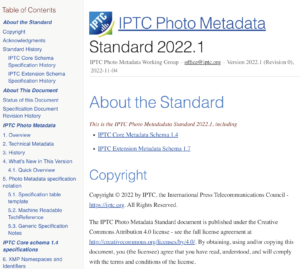 Today, the IPTC announces the release of the IPTC Photo Metadata Standard, version 2022.1.
Today, the IPTC announces the release of the IPTC Photo Metadata Standard, version 2022.1.
The update has some changes to align the IPTC Photo Metadata Standard more closely which IPTC Video Metadata Hub, which helps with the integration into the C2PA specification as announced earlier this week.
The changes will be presented today (Thursday 10 November) at the IPTC Photo Metadata Conference, alongside sessions on AI and images, C2PA, and accessibility. You can still register for today’s Photo Metadata Conference, for free, at the IPTC Photo Metadata Conference 2022 event page. Video recordings from the event will be posted in the coming weeks.
The changes in detail
The IPTC Core schema has been updated to version 1.4, including the following changes:
-
Name of property Source changed to Source (Supply Chain)
-
Property Subject Code was set to legacy state
The IPTC Extension schema has been updated to version
-
New property Contributor (matching the equivalent property in IPTC Video Metadata Hub)
-
The property structure for Product has been extended with a new property Identifier
The specification document has also been updated with some edits and additions to Help Texts and User Notes.
Technical Reference update
The IPTC Photo Metadata TechReference has also been updated to include the changes in version 2022.1. This can be used by software makers to easily include the changes in the new version.
For more information on how to use the Technical Reference, please consult the IPTC Photo Metadata Technical Reference documentation.
Questions? Comments?
For any questions or comments on this update or on the IPTC Photo Metadata Standard in general, please post to the public IPTC Photo Metadata forum at iptc-photometadata@groups.io.
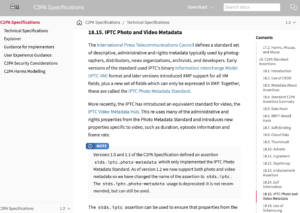
We are happy to announce that IPTC’s work with C2PA, the Coalition for Content Provenance and Authority, continues to bear fruit. The latest development is that C2PA assertions can now include properties from both the IPTC Photo Metadata Standard and our video metadata standard, IPTC Video Metadata Hub.
Version 1.2 of the C2PA Specification describes how metadata from either the photo or video standard can be added, using the XMP tag for each field in the JSON-LD markup for the assertion.
For IPTC Photo Metadata properties, the XMP tag name to be used is shown in the “XMP specs” row in the table describing each property in the Photo Metadata Standard specification. For Video Metadata Hub, the XMP tag can be found in the Video Metadata Hub properties table under the “XMP property” column.
We also show in the example assertion how the new accessibility properties can be added using the Alt Text (Accessibility) field which is available in Photo Metadata Standard and will soon be available in a new version of Video Metadata Hub.
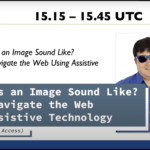
The IPTC Photo Metadata Working Group is proud to announce the IPTC Photo Metadata Conference 2022. The event will be held online on Thursday November 10th from 15.00 – 18.00 UTC.
This year the theme is Photo Metadata in the Real World. After introducing two new developments last year: the IPTC Accessibility properties and the C2PA specification for embedding provenance data in photo and video content – we re-visit both technologies to see how they are being adopted by software systems, publishers and broadcasters around the world.
The 3-hour meeting will host four sessions:
- Adoption of the IPTC Accessibility Properties – we hear from vendors and content creators on how they are progressing in implementing the new properties to support accessibility
- Software Supporting the IPTC Photo Metadata Standard – showcasing an update to IPTC’s directory of software supporting the IPTC Photo Metadata Standard, including field-by-field reference tables letting users compare software implementations
- Use of C2PA in real workflows – showcasing early work on implementing the C2PA specification in media organisations
- Artificial Intelligence and metadata – looking at the questions around copyright and synthetic media: for example, when generative AI uses thousands of potentially copyrighted images to train machine learning models, who owns the resulting images?
We look forward to welcoming all interested parties to the conference – no IPTC membership is needed to attend. The event will be held as a Zoom webinar.
Please see more information and the Zoom registration link on the event page.
See you there on the November 10th!
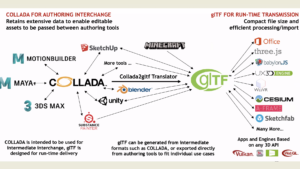
Last week the IPTC held its Autumn Meeting 2022, with over 70 attendees from over 20 countries attending the three-day online event.
Discussions were as wide-ranging as ever. Highlights were a guest presentation on how media organisations can prepare for the Metaverse from startup advisor and previous member of the Microsoft HoloLens team, Toby Allen; intense discussions from members about making our work in machine-readable rights and RightsML simpler and more accessible and to bridge the gap between our simple, lightweight JSON news standard ninjs and our richly structured full-featured XML-based standard NewsML-G2.
We also heard about many other topics:
- Meinolf Ellers at IPTC member dpa spoke about the DRIVE initiative, which follows on from the C-POP project that IPTC advised on in 2019 and 2020. DRIVE allows consortium members to share data about content usage to drive subscriptions and engagement, and to find under-represented areas in their news output to meet audience needs.
- We heard about representing social media content in NewsML-G2: Dave Compton of Refinitiv spoke about their work encoding content from Twitter and other social networks in NewsML-G2 format for re-use, enhancement and syndication.
- Will Kreth, previously CEO of EIDR, spoke about the HAND project which aims to create a unique identifier for media and sports talent
- Fredrik Lundberg from IPTC member iMatrics and guest presenter Jens Pehrson from GOTA Media spoke about a new tool they have developed that allows publishers to track the gender balance in their news content
- Johan Lindgren from IPTC member TT (the Swedish national news agency) spoke about their recent project to develop a classification and entity extraction engine for their news content, based on IPTC Media Topics taxonomy
- We heard from Audren Layeux of CARSA who spoke about the European Media Data Space project, an EU initiative
- Ben Colman, CEO of RealityDefender spoke (direct from TechCrunch Disrupt in San Francisco!) about their deepfake detection technology, used by social media networks, financial institutions and media organisations to detect manipulated images and videos.
- IPTC MD Brendan Quinn spoke about IPTC’s ongoing work with C2PA and Project Origin, including forthcoming additions to C2PA to include video metadata.
In addition, we heard updates from all IPTC Working Groups: Dave Compton introduced NewsML-G2 2.31; Paul Kelly spoke about some new developments in the RDF-based sports data model which will be announced soon; Pam Fisher described the work of the Video Metadata Working Group and the changes coming in Video Metadata Hub v1.4; David Riecks and Michael Steidl spoke about Photo Metadata Standard 2022.1 and the ongoing work of the Photo Metadata Working Group;
The Standards Committee voted in new standard versions: NewsML-G2 v2.31, Video Metadata Hub v1.4, and Photo Metadata Standard 2022.1. These will be released and publicised over the coming weeks.
The IPTC Annual General Meeting 2022 saw Johan Lindgren step down from the Board of Directors after 6 years of service. Thanks very much for all your help, Johan!
We are very happy to welcome a new Board member: Heather Edwards of Associated Press.
Thanks very much to everyone who attended and spoke. You contributed to making it a great event for all!
As usual, full recordings of all sessions are available to IPTC members on the members-only event page.
Family Tree magazine has published a guide on using embedded metadata for photographs in genealogy – the study of family history.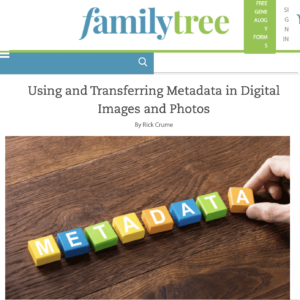
Rick Crume, a genealogy consultant and the article’s author, says IPTC metadata “can be extremely useful for savvy archivists […] IPTC standards can help future-proof your metadata. That data becomes part of the digital photo, contained inside the file and preserved for future software programs.”
Crume quotes Ken Watson from All About Digital Photos saying “[IPTC] is an internationally recognized standard, so your IPTC/XMP data will be viewable by someone 50 or 100 years from now. The same cannot be said for programs that use some proprietary labelling schemes.”
Crume then adds: “To put it another way: If you use photo software that abides by the IPTC/XMP standard, your labels and descriptive tags (keywords) should be readable by other programs that also follow the standard. For a list of photo software that supports IPTC Photo Metadata, visit the IPTC’s website.“
“[IPTC] is an internationally recognized standard, so your IPTC/XMP data will be viewable by someone 50 or 100 years from now”
The article goes on to recommend particular software choices based on IPTC’s list of photo software that supports IPTC Photo Metadata. In particular, Crume recommends that users don’t switch from Picasa to Google Photos, because Google Photos does not support IPTC Photo Metadata in the same way. Instead, he recommends that users stick with Picasa for as long as possible, and then choose another photo management tool from the supported software list.
Similarly, Crume recommends that users should not move from Windows Photo Gallery to the Windows 10 Photos app, because the Photos app does not support IPTC embedded metadata.
Crume then goes on to investigate popular genealogy sites to examine their support for embedded metadata, something that we do not cover in our photo metadata support surveys.
The full article can be found on FamilyTree.com.

Where else can you hear about the difficulties of examining photo metadata in NFTs, see a lifelike image of a human being generated from pure data before your eyes, see how Wikidata can be used to take semantic fingerprints of news articles, and discover that an hour is nowhere near long enough to discuss simplifying machine-readable rights? Nowhere but the IPTC Meeting, of course! And this year’s Spring Meeting was the venue for all of this and much more.
We held the meeting virtually from Monday May 16 to Wednesday May 18th, and attending were over 70 people from at least 45 organisations across more than 20 countries.
Along with our usual Working Group updates and committee meetings, we invited speakers from several fascinating startups, services and projects at member companies. Here’s a quick summary of their sessions:
- We heard from Kairntech who are working on a classification system based on extracting entities from news stories and building a “semantic fingerprint” which can be used for cross-language classification, search and content enhancement
- The New York Times’ R&D Lab presented PaperTrail, a project to enhance the quality of the Times’ print archive through the use of machine learning to improve on basic OCR techniques (they’re looking for collaborators, more info coming soon!)
- Bria.ai showed us how an API can be used to enhance and create images and videos through the use of a custom GAN model trained in a “responsible AI” method
- Margaret Warren talked us through her efforts in creating and selling an NFT, looking at the process view the perspective of a photo metadata expert
- Consultant and author Henrik de Gyor talked us through the latest in synthetic media, which will be helpful in helping us to finalise our Digital Source Type vocabulary for synthetic media
- Laurent Le Meur from EDRLab presented his project’s recommendation on a Text and Data Mining Reservation Protocol, which can be used by publishers to restrict the rights of data miners in scraping any content for the purpose of analysis or building a model
- We heard from Dominic Young of Axate on his approach to offer pay-as-you-go payment options on paywalled news sites based on a simple pre-paid wallet mechanism.
We also had many announcements and discussions around IPTC standards, many of which we will be revealing in the coming months. One notable update is that the Standards Committee approved ninjs version 1.4 which we will release soon.
Thanks to all the IPTC members, Working Group leads, committee members and guests who made this member meeting one to remember.
Anyone who has managed photo metadata can attest that it is often difficult to know which metadata properties to use for different purposes. It is especially tricky to know how to tag consistently across different metadata standards. For example, how should a copyright notice be expressed in Exif, IPTC Photo Metadata and schema.org metadata?
For software vendors wanting to build accurate mapping into their tools to make life easier for their customers, it’s no easier. For a while, a document created by a consortium of vendors known as the Metadata Working Group solved some of the problems, but the MWG Guidelines are no longer available online.
To solve this problem, the IPTC collaborated with Exif experts at CIPA, the camera products industry group that maintains the Exif standard. We also spoke with the team behind schema.org. Based on these conversations, we created a document that describes how to map properties between these formats. The aim is to remove any ambiguity regarding which IPTC Photo Metadata properties are semantically equivalent to Exif tags and schema.org properties.
Generally, Exif tags and IPTC Photo Metadata properties represent different things: Exif mainly represents the technical data around capturing an image, while IPTC focuses on describing the image and its administrative and rights metadata, and schema.org covers expressing metadata in a web page. However, quite a few properties are shared by all standards, such as who is the Creator of the image, the free-text description of what the image shows, or the date when the image was taken. Therefore it is highly recommended to have the same value in the corresponding fields of the different standards.
The IPTC Photo Metadata Mapping Guidelines outlines the 17 IPTC Photo Metadata Standard properties with corresponding fields in Exif and/or Schema.org. Further short textual notes help to implement these mappings correctly.
The intended audience of the document is those managing the use of photo metadata in businesses and the makers of software that handles photo metadata.The IPTC Photo Metadata Mapping Guidelines document can be accessed on the iptc.org website. We encourage IPTC members to provide feedback through the usual channels, and non-members to respond with feedback and questions on the public IPTC Photo Metadata email discussion group.
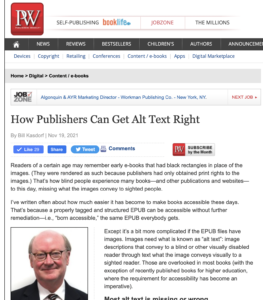
Bill Kasdorf, IPTC Individual Member, has written about IPTC Photo Metadata in his latest column for Publishers Weekly.
In the article, a double-page spread in the printed version of the 11/22/2021 issue of Publishers Weekly and an extended article online, Bill references Caroline Desrosiers of IPTC Startup member Scribely saying “if publications are born accessible, then their images should be born accessible, as well.”
The article describes how the new Alt Text (Accessibility) and Extended Description (Accessibility) properties in IPTC Photo Metadata can be used to make EPUBs more accessible.
Bill goes on to provide an example, supplied by Caroline Desrosiers, of how an image’s caption, alt text and extended description fulfil very different purposes, and mentions that it’s perfectly fine to leave alt text blank in some cases! For more details, read the article here.
We had a great IPTC Photo Metadata Conference last week, focussing on accessibility, interoperability and authenticity.
Videos of all sessions are embedded in this post. Videos are also available from the event page. All videos have subtitles available – just click the “CC” button in the YouTube toolbar at the bottom of each video.
We started off with an introduction from IPTC Managing Director, Brendan Quinn:
Accessibility and “Born Accessible Content”
We then went into the first session, where David Riecks, co-lead of the IPTC Photo Metadata Working Group, introduced the new accessibility properties in the IPTC Photo Metadata Standard:
Next up was Sam Joehl of Level Access, who gave a fascinating presentation showing how a screen-reader application deals with images on the web, showcasing the need for good alternative text and image descriptions:
Next was a panel moderated by Caroline Desrosiers of Scribely, entitled Making Images Accessible Across Industries: How Does it Work and What’s Next? Speakers included James Tiller, Cailin Meyer and Rebecca Snyder of the Smithsonian Institution, Rachel Comerford from Macmillan Learning and Jon Sasala from Morey Creative Studios. The subject matter ranged from Smithsonian’s image description guidelines for scientific research to Macmillan’s “Born Accessible Content” initiative to the problems with “overlay” software that attempts to write alt text automatically. View the session here:
The next panel was moderated by David Riecks, and focused on “Image Accessibility Behind the Scenes: Metadata, DAMs, and Workflows.” Speakers were Andrew Kirkpatrick, Director of Accessibility at Adobe, Margaret Warren, founder of ImageSnippets, and Janos Farkas, CEO of CLink Media. This session looked at the implementor’s view and covered issues around user interfaces, ensuring metadata stays with images throughout their lifecycles, and of course asked when the new accessibility properties would be available in Adobe products!
Interoperability with Michael Steidl
Next up we moved on from accessibility to the second theme of the day, Interoperability. Michael Steidl, the other co-lead of the IPTC Photo Metadata Working Group, demonstrated IPTC’s Photo Metadata Interoperability Tests, new tools to allow users and vendors to test the capabilities of image management software, and compare their metadata handling to the IPTC Photo Metadata Standard specification.
Authenticity, CAI and C2PA
The third theme of the day was authenticity. We invited Santiago Lyon, Head of Advocacy and Education for the Adobe-led Content Authenticity Initiative, to speak about the CAI and its sister project, C2PA – the Coalition for Content Authenticity and Provenance. We looked at some details around how C2PA technology will fulfil the requirements of CAI to provide tamper-evident images and videos.
Finally, Brendan gave some final comments and discussed the details that we know so far about next year’s event. He also encouraged everyone to join the Friends of IPTC Newsletter, so that they can be the first to hear about next year’s event!
The latest version of the International Press Telecommunications Council IPTC’s Photo Metadata Standard includes two new properties: Alt Text (Accessibility) and Extended Description (Accessibility). These will make it easier for software companies, publishers, and website developers to make websites and electronic publications more accessible.
These new properties will be introduced to the public and discussed in detail at the IPTC Photo Metadata Conference, held online next Thursday, 4th November. Registration to the IPTC Photo Metadata Conference is free and open to all.
“A major milestone in accessibility is realised through the inclusion of embedded alt text and extended descriptions as IPTC metadata for digital images,” said Beth Ziebarth, Director of Access Smithsonian. “All publicly available images can now be made accessible. As with any good inclusive practice, this benefits a range of digital image users and producers. The foresight of the IPTC Photo Metadata Working Group is commendable.”
Web accessibility is mission-critical in our digitally inclusive age. As the number of images added to the web increases every day, the visual gap widens for people using assistive technologies, especially if they are blind. Embedding image descriptions for accessibility into photo metadata promises to be a game-changer, making it possible for software and systems to routinely provide alt text with images, thus giving screen reader software the ability to help readers visualise and listen to image descriptions as they are read out loud. Without accessible descriptions, images are silent for the millions who rely on screen readers to fully access the web.
As Richard Orme, CEO of the DAISY Consortium, has pointed out, “Up to 250 million people with blindness or moderate to severe vision impairment can benefit from image descriptions, plus countless more people with diverse information processing differences such as dyslexia who use text-to-speech technology for reading.”
The year 2020 was pivotal for web accessibility. Many disabled people were at high risk of severe illness from COVID-19 but struggled to access the essentials online — everything from healthcare and education to groceries and supplies. Inaccessible websites and applications have always been a barrier; during COVID, they became a threat to the health and safety of a vulnerable population.
Image descriptions are essential for people with visual impairments using assistive technologies and a fundamental requirement of the World Wide Web Consortium’s (W3C) Web Content Accessibility Guidelines (WCAG), the most widely-used guidelines for web accessibility in the world (W3C Web Accessibility Laws and Policies).
IPTC’s new accessibility properties will make it easier for platforms and software to comply with WCAG requirements and deliver images that are inclusive for everyone. Embedding accessible image descriptions into the photo metadata will make it possible for alt text and extended descriptions to travel wherever the image goes on the web or in books or other documents provided as EPUBs.
If you are interested, there are a few things you can do now:
- Attend the IPTC Photo Metadata Conference on November 4th to understand more about the new properties and how you can use them.
- Contact your software providers to tell them about these new properties and emphasise that these features are very important to you. Ask them when they will make the new properties available in their user interface.
- Contact your web content management software provider to make that case as well.
- For larger enterprises, think about how you could implement these properties into your organisation’s workflow.
The online IPTC Photo Metadata Standard specification will be updated to the new version on 4 November 2021.
